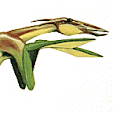Click to enlarge.
From: Gould SJ, Ed. The book of Life. Ebury Hutchinson London 1993.
From: Gould SJ, Ed. The book of Life. Ebury Hutchinson London 1993.
To see where that came from, we have to go back, either to the Devonian or, more appropriately, to books on palaeontology up to about 10 years ago. The image above is from such a book, still available from Amazon in the UK and in the USA. No doubt you have seen similar images before, illustrating how Earth's tetrapod legs evolved from the fins of fish. In the middle right, you will see such a prototypical tetrapod leg: one bone in the upper limb, two parallel bones in the lower limb (the radius and the ulna), a bunch of small bones as a sort of shock absorbers, and five (well, seven) parallel digits with several bones in series. That is basically our arm or our leg. The middle image on the left shows the bones in the ancestral fish limb. Do you see the resemblance? If you do, good for you. I never did, as to me the branching patterns seemed completely different. In effect, the two boned destined to become the radius and ulna may start parallel where they touch the upper limb bone, but their lengths are quite different, and while there are no other bones connected to the radius, some do connect to the ulna. In fact, if you start at the upper arm, there is just one other bone at the front of the limb before you reach the 'lepidotrichia' (the stiffening rods in the fin), but there are three at the hind end of the fin.

Click to enlarge.
Sébastien Steyer. La Terre avant les dinosaures. Copyright Belin 2009
Sébastien Steyer. La Terre avant les dinosaures. Copyright Belin 2009
This branching pattern was never explained in such books. In a newer book by Sébastien Steyer, (who by the way is not just a palaeontologist but one of the driving forces behind the future book on future animals I discussed here earlier) you will find the images above. Mind you, besides the French and Dutch versions it is also available in English. The left part shows the fin/limb skeleton of Ichthyostega, and to the right Sébastien has shown a series of limbs showing intermediate forms. Very well, I believe the transition happened, but have never stopped wondering about the branching patterns.
Click to enlarge. Copyright Gert van Dijk
So here are some old sketches. The one on the left in the middle row is more or less our current branching pattern: all fingers have equal numbers of segments (phalanges) and in the middle one of that row I experimented with different patterns: you could first split a limb into two parts and have these two each split into two more, etc. That would be equally 'consistent' in the sense that the number of steps from wrist to tip of a toe is the same. But in the right one on the middle row I played with another way of branching, in which some bones both give rise to a new bone and also continue downwards themselves. In the bottom row I developed the latter pattern some more, finally arriving at the right one, which looks like Ichthyostega's skeleton.
Click to enlarge. Copyright Gert van Dijk
And finally some sketches that show the design taken to extreme consequences. The left one is designed for a marshland creature that needs to spread its weight over a large surface. Mind you, I would never equip Furahan animals with legs that split that far up. I do not think that that makes much sense, as it will double the weight without appreciable advantages. Toes are good for many things: one good thing about them is that they extend stride length, and another is that they help spread weight, act as shock absorbers and help direct forces. Are more toes and longer toes therefore better than few short ones? Well, for these purposes, yes. But there is always a need to conserve mass and energy, so fewer and thinner bones have advantages too. As always, there is an optimum.
The foot on the right is suitable for a very heavy animal of a not too athletic build, rather like an elephant. Its toes are mostly there as shock absorbers and a means to transfer ground forces. They are good for standing and walking sedately. This particular design is not at all suited for athletic animals though, as the toes do not help extend stride length at all: they are much too short for that and hardly bend at all. If you want toes for an athletic animal, think of the feet of a chicken or a tyrannosaur. Well, now you known why I not like the feet of many of Barlowe's animals in 'Expedition' that much: he equipped active athletic animals with unsuitable elephantine feet.
But I digress. In the current Furahan redesign, I decided to build the anatomy of hexapod feet on a pattern that I thought I saw in the fin/feet of Devonian amphibians, that never seemed to be explained. So that is where the marblebill got its feet.



